Physician Engagement (Slide Presentation)
On the CUSP: Stop BSI
Contents
Slide 1. Physician Engagement
Slide 2. Image
Slide 3. Learning Objectives
Slide 4. What Do We Mean by Engagement?
Slide 5. Where Does Engagement Fit?
Slide 6. Stages of Engagement
Slide 7. Engage Physician's Intellect
Slide 8. Engage by Creating Trust
Slide 9. Physician Engagement Strategies
Slide 10. Physician Engagement Strategies
Slide 11. Example: Physician Champion Compact
Slide 12. Example: Physician Champion Compact
Slide 13. Physician Engagement Strategies
Slide 14. Physician Engagement Strategies
Slide 15. Handling Barriers to Change
Slide 16. Manage Communication
Slide 17. Action Plan
Slide 18. Image
Slide 1. Physician Engagement
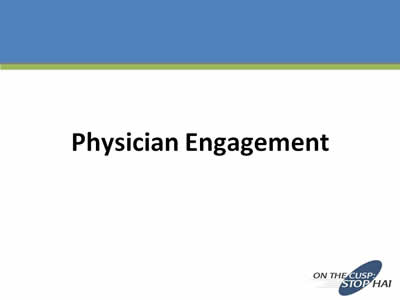
Slide 2. Image

Image of a baby on the sand at the beach.
Slide 3. Learning Objectives
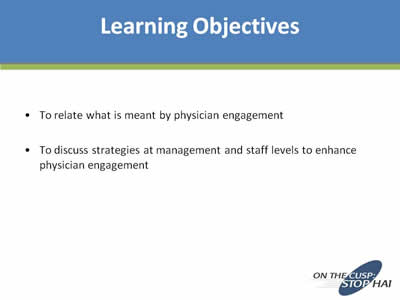
- To relate what is meant by physician engagement
- To discuss strategies at management and staff levels to enhance physician engagement
Slide 4. What Do We Mean By Engagement?
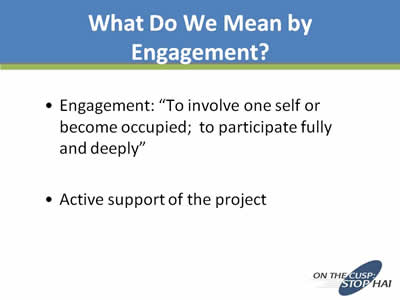
- Engagement: “To involve one self or become occupied; to participate fully and deeply”
- Active support of the project
Slide 5. What Does Engagement Fit?
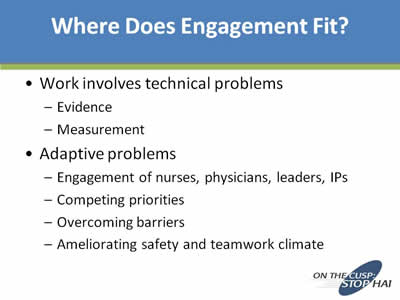
- Work involves technical problems
- Evidence
- Measurement
- Adaptive problems
- Engagement of nurses, physicians, leaders, IPs
- Competing priorities
- Overcoming barriers
- Ameliorating safety and teamwork climate
Slide 6. Stages of Engagement
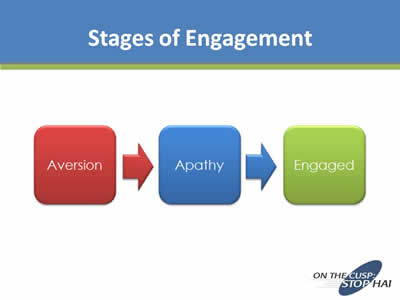
Image of a chart showing Aversion leading to Apathy leading to Engaged.
Slide 7. Engage Physician's Intellect
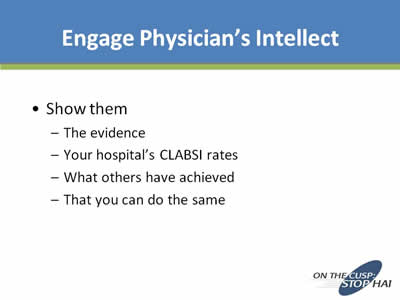
- Show them
- The evidence
- Your hospital’s CLABSI rates
- What others have achieved
- That you can do the same
Slide 8. Engage by Creating Trust
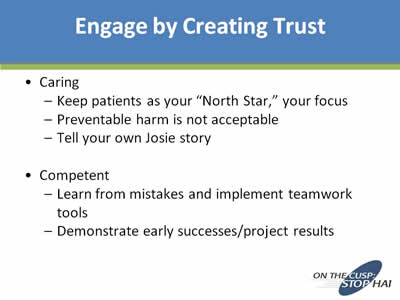
- Caring
- Keep patients as your “North Star,” your focus
- Preventable harm is not acceptable
- Tell your own Josie story
- Competent
- Learn from mistakes and implement teamwork tools
- Demonstrate early successes/project results
Slide 9. Physician Engagement Strategies
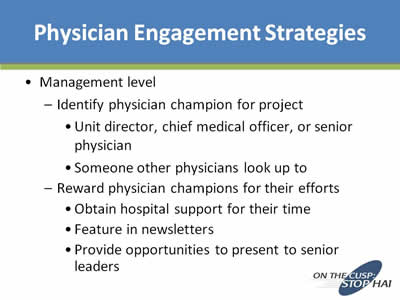
- Management level
- Identify physician champion for project
- Unit director, chief medical officer, or senior physician
- Someone other physicians look up to
- Reward physician champions for their efforts
- Obtain hospital support for their time
- Feature in newsletters
- Provide opportunities to present to senior leaders
- Identify physician champion for project
Slide 10. Physician Engagement Strategies
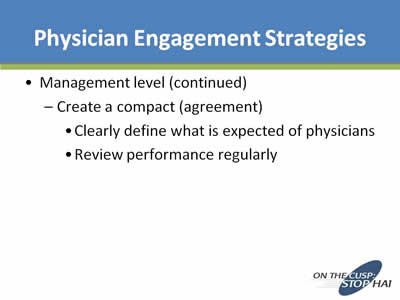
- Management level (continued)
- Create a compact (agreement)
- Clearly define what is expected of physicians
- Review performance regularly
- Create a compact (agreement)
Slide 11. Example: Physician Champion Compact
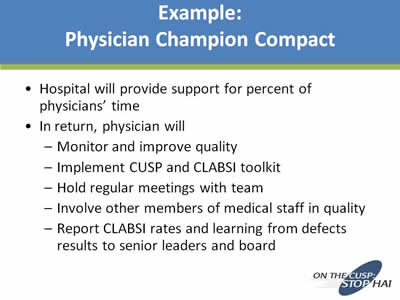
- Hospital will provide support for percent of physicians’ time
- In return, physician will
- Monitor and improve quality
- Implement CUSP and CLABSI toolkit
- Hold regular meetings with team
- Involve other members of medical staff in quality
- Report CLABSI rates and learning from defects results to senior leaders and board
Slide 12. Example: Physician Champion Compact
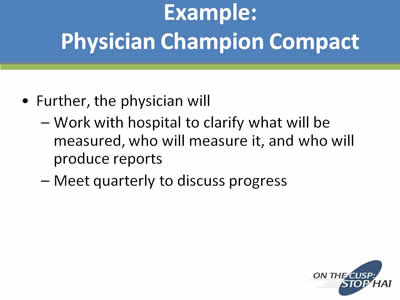
- Further, the physician will
- Work with hospital to clarify what will be measured, who will measure it, and who will produce reports
- Meet quarterly to discuss progress
Slide 13. Physician Engagement Strategies
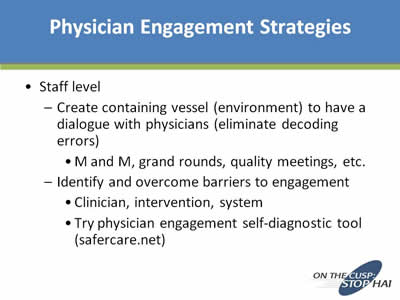
- Staff level
- Create containing vessel (environment) to have a dialogue with physicians (eliminate decoding errors)
- M and M, grand rounds, quality meetings, etc.
- Identify and overcome barriers to engagement
- Clinician, intervention, system
- Try physician engagement self-diagnostic tool (safercare.net)
- Create containing vessel (environment) to have a dialogue with physicians (eliminate decoding errors)
Slide 14. Physician Engagement Strategies
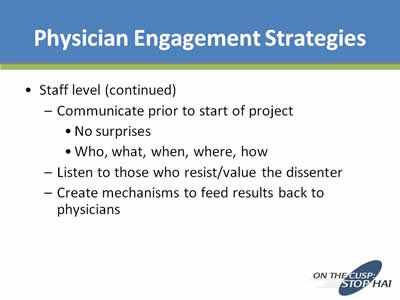
- Staff level (continued)
- Communicate prior to start of project
- No surprises
- Who, what, when, where, how
- Listen to those who resist/value the dissenter
- Create mechanisms to feed results back to physicians
- Communicate prior to start of project
Slide 15. Handling Barriers to Change
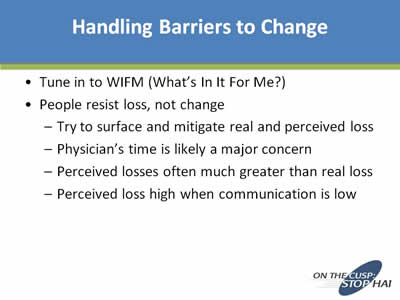
- Tune in to WIFM (What’s In It For Me?)
- People resist loss, not change
- Try to surface and mitigate real and perceived loss
- Physician’s time is likely a major concern
- Perceived losses often much greater than real loss
- Perceived loss high when communication is low
Slide 16. Manage Communication
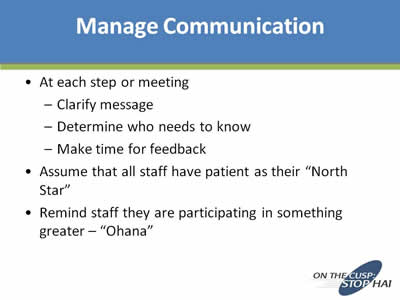
- At each step or meeting
- Clarify message
- Determine who needs to know
- Make time for feedback
- Assume that all staff have patient as their “North Star”
- Remind staff they are participating in something greater – “Ohana”
Slide 17. Action Plan
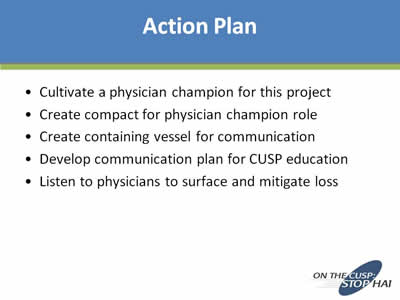
- Cultivate a physician champion for this project
- Create compact for physician champion role
- Create containing vessel for communication
- Develop communication plan for CUSP education
- Listen to physicians to surface and mitigate loss
Slide 18. Image of Baby on Sand




